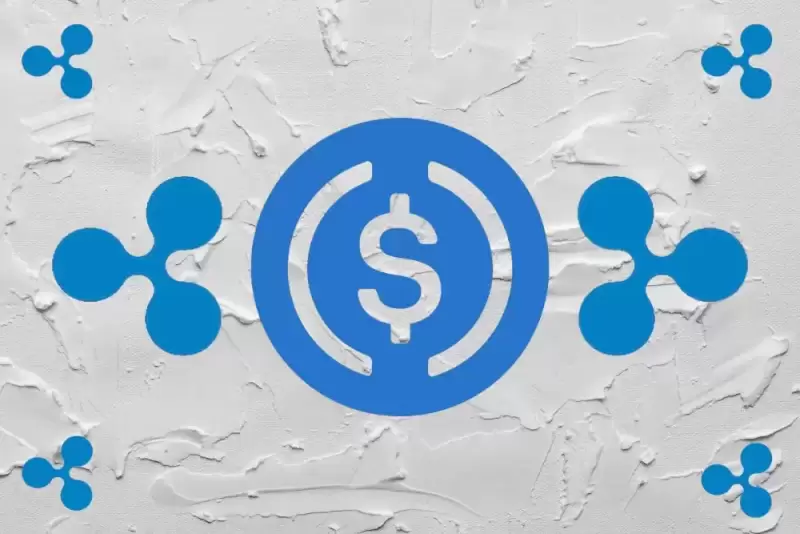 |
|
 |
|
 |
|
 |
|
 |
|
 |
|
 |
|
 |
|
 |
|
 |
|
 |
|
 |
|
 |
|
 |
|
 |
|
Cryptocurrency News Articles
Rumors of Ripple Acquiring Circle Have Been Spreading, But the Valuation Doesn't Make Sense
May 02, 2025 at 04:59 pm
Rumors of Ripple potentially acquiring Circle have spread on social media, driven by reports of their strategic alignment in the stablecoin market.

Rumors have been swirling on social media about the possibility of Ripple acquiring Circle, with reports suggesting the two companies could be aligning their strategies in the stablecoin market.
However, according to crypto commentator Dom in a recent post on X, there is little chance that Ripple would offer anything close to $20 billion to acquire Circle. A more realistic valuation for Circle, according to Dom, would be around $5 billion, which better reflects the company’s financial performance.
“fyi @circle IPO valuation is ~$5 billion (which is the valuation Ripple is looking at when it made its acquisition offer).
there is no way Ripple would offer $20 billion for Circle.
ps i see lots of people saying $5 billion is a low offer since circle holds $60 billion in USDC and they have huge user base. but USDC liquidity is not transferrable to another entity. it will be liquidated if anything. also, circle’s revenue model is mainly yield on these reserves, not user fees or transaction fees like other crypto companies. so we should value circle based on its income potential, not the collateral.”
Understanding Circle’s True Valuation
Circle, the issuer of the popular USD Coin (USDC) stablecoin, is a well-known player in the digital payments industry. Currently, Circle manages the issuance of approximately $60 billion worth of USDC, all of which is backed by collateralized reserves in highly liquid assets such as U.S. Treasuries and cash equivalents.
This large reserve figure often leads some to believe that the company itself is valued at $60 billion, but Dom clarifies that this isn’t the case. The assets are specifically allocated to back the stablecoins in circulation, not to build up Circle’s balance sheet. Instead, Circle generates revenue through the yield realized on these reserves.
This yield—accumulated from interest on short-term government securities and other low-risk instruments—contributes to Circle’s earnings, which in turn determine its enterprise valuation.
Ripple’s Acquisition Logic Doesn’t Support a $20 Billion Bid
Considering this business model, Dom argues that Circle’s $5 billion IPO valuation is a more accurate assessment of its income potential. From a corporate finance standpoint, it’s unlikely that Ripple would offer a premium of 4x over that figure, especially since the collateral backing USDC isn’t transferrable or revenue-generating.
With its own ambitions in the stablecoin space and broader payments ecosystem, Ripple has little incentive to overpay for Circle. The company recently announced its entry into the stablecoin market with RLUSD, a new XRP Ledger-native stablecoin backed 1:1 by U.S. dollar reserves.
As Ripple is now launching its own digital dollar equivalent, a $20 billion acquisition bid for a competitor seems even less plausible. The decision to acquire a company like Circle would depend on various factors, including current revenue, future cash flows, regulatory risks, and market competitive landscape.
Given the increasing regulatory scrutiny on stablecoins and Circle’s revenue model, which is largely dependent on interest rates, paying a high premium would carry significant risks.
Market Misunderstandings and Misinformation
Dom’s post also touches upon a broader misunderstanding within the crypto community: conflating collateral managed by a company with its equity value. This oversight can inflate company valuations, especially in the stablecoin sector, where a large portion of assets are held in custody.
To be clear, the $60 billion in assets isn’t available for Circle to use for growth or acquisitions. These funds are specifically allocated to redeem USDC if needed.
Instead, Circle’s enterprise value should be assessed through more standard metrics, such as revenue potential from interest earnings, future growth prospects, expansion of their user base, and strategic positioning in the broader market. All of these fundamentals contribute to the $5 billion valuation, not the speculative $20 billion figure.
Rational Valuations in an Evolving Ecosystem
As the competition in the stablecoin market intensifies with new entrants like PayPal and financial institutions joining the space, strategic acquisitions will likely play a role in shaping the future of digital finance. However, companies like Ripple, which take a calculated, enterprise-focused approach, are unlikely to be easily enticed into making such moves.
Ripple is known for its focus on utility, scalability, and sustainable revenue models, which suggests they wouldn’t be easily swayed by hype. Dom’s breakdown of Circle’s valuation highlights why any serious acquisition offer would be grounded in financial reality.
Disclaimer:info@kdj.com
The information provided is not trading advice. kdj.com does not assume any responsibility for any investments made based on the information provided in this article. Cryptocurrencies are highly volatile and it is highly recommended that you invest with caution after thorough research!
If you believe that the content used on this website infringes your copyright, please contact us immediately (info@kdj.com) and we will delete it promptly.
-

-

-

- Why This Low-Cap Altcoin-RCOF Is Beating the Market Right Now
- May 03, 2025 at 09:15 am
- RCO Finance isn't simply riding the present market euphoria. It's developing a robust platform for modern investors, providing access to cryptocurrency, stocks, ETFs, and even tokenized real estate, all in one location.
-

- Troller Cat Presale Sets Sail on Presale Journey Amid Bearish Trends for Dogecoin and FLOKI
- May 03, 2025 at 09:15 am
- Meme Coins in the Spotlight: A Tale of Three Tokens. The crypto market has been a rollercoaster lately, with major players like Bitcoin and Ethereum experiencing significant fluctuations.
-

-

-

-

-

























































